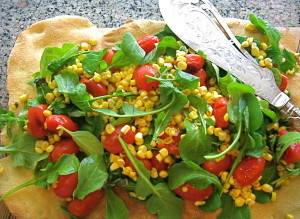
Heroes, as you know, fight evil and stuff. What you may not know is they don’t always get to wear capes. Or have distinguishing features like a lightning-bolt scar on their foreheads.
More often, heroes go around unnoticed, unsung, with dirt-stained jeans. I’m talking about your local farmers.
Imagine what it takes to feed a meal to one household. Now multiply that by three meals a day. Now multiply that by how many people live in your city. Factor in any or all of the climate-related crap growers have been facing, be it the swath of drought across the southeast, the floods in the midwest or the wildfires on the west coast. Maybe they believe it’s caused by climate change, maybe they don’t — either way, the small farmers serving your community are working to grow your food, despite outrageous challenges, from economic to environmental. That makes them local heroes. And they’re your neighbors.
In a small, tight community, you can know your local heroes by sight — you buy your tomatoes from the guy at the end of your road, you carpool with the owner/manager/shelf-stocker/jam-maker of an indie market. A larger, more urban environment may have more heroes than DC Comics — farmers, gardeners, cheese makers, organic bread bakers, food co-op and community shared agriculture members — but you may not know who they are. It’s time to change that.
Start with a visit to your local farmers market. Most markets are boasting luscious summer produce like organic (not GMO) corn, heirloom tomatoes, ripe, juicy berries and sun-warm peaches at bumper crop prices, so why resist? Go up to the guy who’s selling fresh, fabulous stuff and say hi. Find out who he is and what makes him want to do it (because honey, there are easier ways of making a living). Plunking down your money is a good idea, too.
Buying local means you’re supporting the farmers who feed you, and it means supporting your own community rather than putting your green into the not-so-green fist of agribusiness. It means you’re lightening your carbon load, since you aren’t paying to ship your food from afar.
Supporting your local farmer makes you a local hero, too. And it’s easy. There’s over 6,000 farmers markets across the country, a 16 percent increase from just two years back.
If your own community has been farmers market bereft, be a local hero and help create one in your hometown. Get involved with local green initiatives and food policy. Being a local hero means advocating for a community where fresh food is accessible to all. Be totally hands-on — volunteer at your community soup kitchen or food pantry. Grow your own food. Start an organic garden in your backyard or at your kid’s school.
We need to feel a vested interest and ownership in our communities and support them as if our lives depend on it. Because they do. We are all neighbors and we all depend on each other.
Connecting locally leads to other connections — more friends, better food, a greater sense of the environmental, economic and political issues that all play a role in bringing tonight’s dinner to your plate. It’s easier to wrap your head around ginormous issues like GMOs, factory farming and the Farm Bill when you know — and support — your local farmer.
The local movement is exciting, it’s heroic, and it takes root when we all participate. And if you want to get a superhero cape, it’s fine with me.
Cornmeal Flatbread with Local Farmers Market Corn, Tomatoes and Basil
This is not quite a pizza, more like a salad served on an edible plate. The juices from the corn and tomatoes help keep topping in place, but you’ll want a fork and knife, too.
You can use any kind of prepared pizza dough instead, but this cornmeal flatbread recipe accentuates the sweet taste of summer corn, and from proofing the yeast to baking the pie, takes about half an hour. Plus, you can’t get more local than homemade.
Tomato, Corn and Basil Salad
1 tablespoon olive oil
1 pint grape or cherry tomatoes
2 ears corn, cut from cob (about 1-1/2 cups kernels)
1 pinche sea salt
1 big bunch basil leaves (about 1/2 cup)
2 big handfuls arugula (about 2 cups)
Heat oil in a medium saucepan over medium-high heat. Add grape or cherry tomatoes, give pan a shake to coat tomatoes in oil.
Cover, reduce heat to medium and cook for 7 to 10 minutes, or until tomatoes start to pop.
Add corn kernels and a pinch of sea salt. Remove from heat and let cool.
Tomato-corn mixture may be made up to a day ahead and kept covered and chilled in the refrigerator.
Cornmeal Flatbread
1 cup unbleached all-purpose flour
1 tablespoon sugar
1-1/4 teaspoons (1 packet) dry yeast
3/4 cup warm water
1 tablespoons olive oil
1/2 cup whole wheat flour
1/3 cup yellow cornmeal
1 pinch sea salt
Preheat oven to 450.
In a medium bowl, stir together the sugar, yeast, 3/4 cups unbleached flour and remaining pinch of sea salt. Stir in warm water and 1 tablespoon olive oil. Mix well for 1 minute. Work in remaining all-purpose flour, whole wheat flour and cornmeal.
Turn out onto a lightly floured surface and knead until smooth, glossy and elastic — about 5 minutes.
Cover dough and let it rest for 10 minutes.
Sprinkle additional corn meal on a 14×10-inch cookie sheet. Press dough onto cookie sheet and prick with a fork.
Bake for 15 minutes, or until pizza dough is golden and crusty.
Remove from oven and let cool slightly.
Meanwhile, toss tomato-corn mixture with basil and arugula leaves. Season to taste.
Mound salad on top of flatbread. Serve at once.
Article courtesy of huffingtonpost.com

